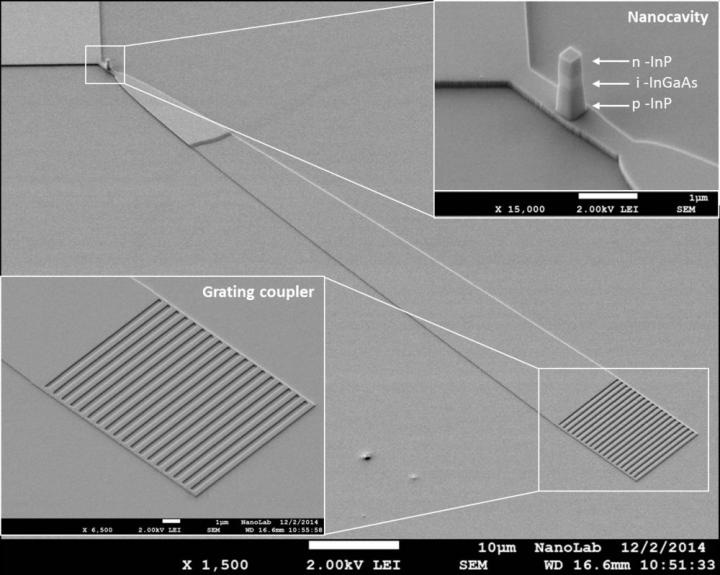Feb 3 2017
Considering the rapid growth of data traffic across the globe, there is congestion of electronic data connections between and within microchips. Although optical connections are the apparent successors, the need for an adequate nanoscale light source for optical data transmission requires has not been met. At present, researchers from the Eindhoven University of Technology (TU/e) have developed a light source with the optimum features, i.e. a nano-LED with a higher efficiency of 1000 times when compared to its predecessors. This nano-LED has the ability of handling data speeds of up to gigabits per second. The results of the research have been published in Nature Communications, an online journal.
 A SEM-picture of the new nano-LED, including some details. CREDIT: Eindhoven University of Technology.
A SEM-picture of the new nano-LED, including some details. CREDIT: Eindhoven University of Technology.
Nano- or microwatts
With electrical cables reaching their limits, it has made optical connections such as fiberglass the standard for data traffic. In the case of long-distance transmission nearly the entire data transmission is optical. Although the growth of data traffic within microchips and computer systems is rapid as well, to date, that traffic is electronic, and hence gradually becoming congested. As these connections, i.e. “interconnects”, are the reason for the major portion of the energy consumption of chips, many researchers across the globe are working in enabling optical, or photonic, interconnects. In order to achieve this, a critical factor is to design a light source that converts data into light signals to be small enough to be positioned into the microscopic structures in microchips. Nevertheless, the efficiency and output capacity ought to be optimal. A particularly challenging aspect is the efficiency because small light sources powered by micro- or nanowatts have found to be highly inefficient till date.
Less light is lost
Recently, a research team from TU/e created a new light-emitting diode (LED) of few hundred nanometers. This integrated LED has an integrated light channel (waveguide) for transporting the light signal, and is 1000 times more efficient when compared to better versions created elsewhere. The TU/e researchers have specifically achieved a breakthrough in terms of the quality of the integrated coupling of the light source and the waveguide, where there is far less loss of light, thus leading to far more entry of light into the waveguide. While at present the efficiency of the new nano-LED is between 0.01% and 1%, the research team anticipates that adopting a new production technique can lead to further increase in this value.
Membrane
One more salient feature of the new nano-LED is that it is integrated into a silicon substrate positioned on a membrane of indium phosphide. Although silicon is the basic material for fabricating microchips, it is not appropriate for light sources. Furthermore indium phosphide is highly suitable for light sources. In addition, several investigations have shown that the new element has the ability not only to rapidly convert electrical signals into optical signals but also to handle several gigabits per second data speeds.
Viable
The TU/e researchers are convinced that the new nano-LED can prove to be a practicable solution for the rapid growth of data traffic on chips. Yet, the researchers are cautious regarding the potential use of the new nano-LED. The new nano-LED has not yet been developed completely to a stage where its industrial usage is viable. Also, necessary production technique is still under wraps.